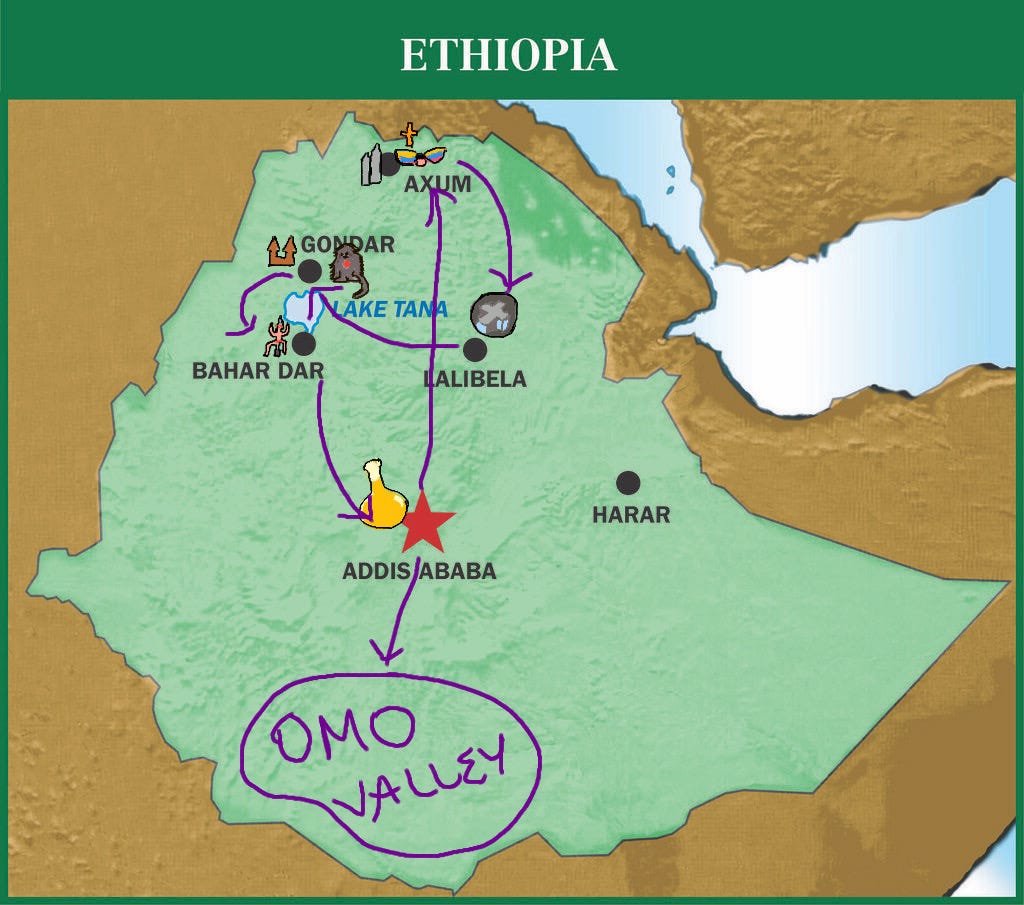Ethiopia / ኢትዮጵያ
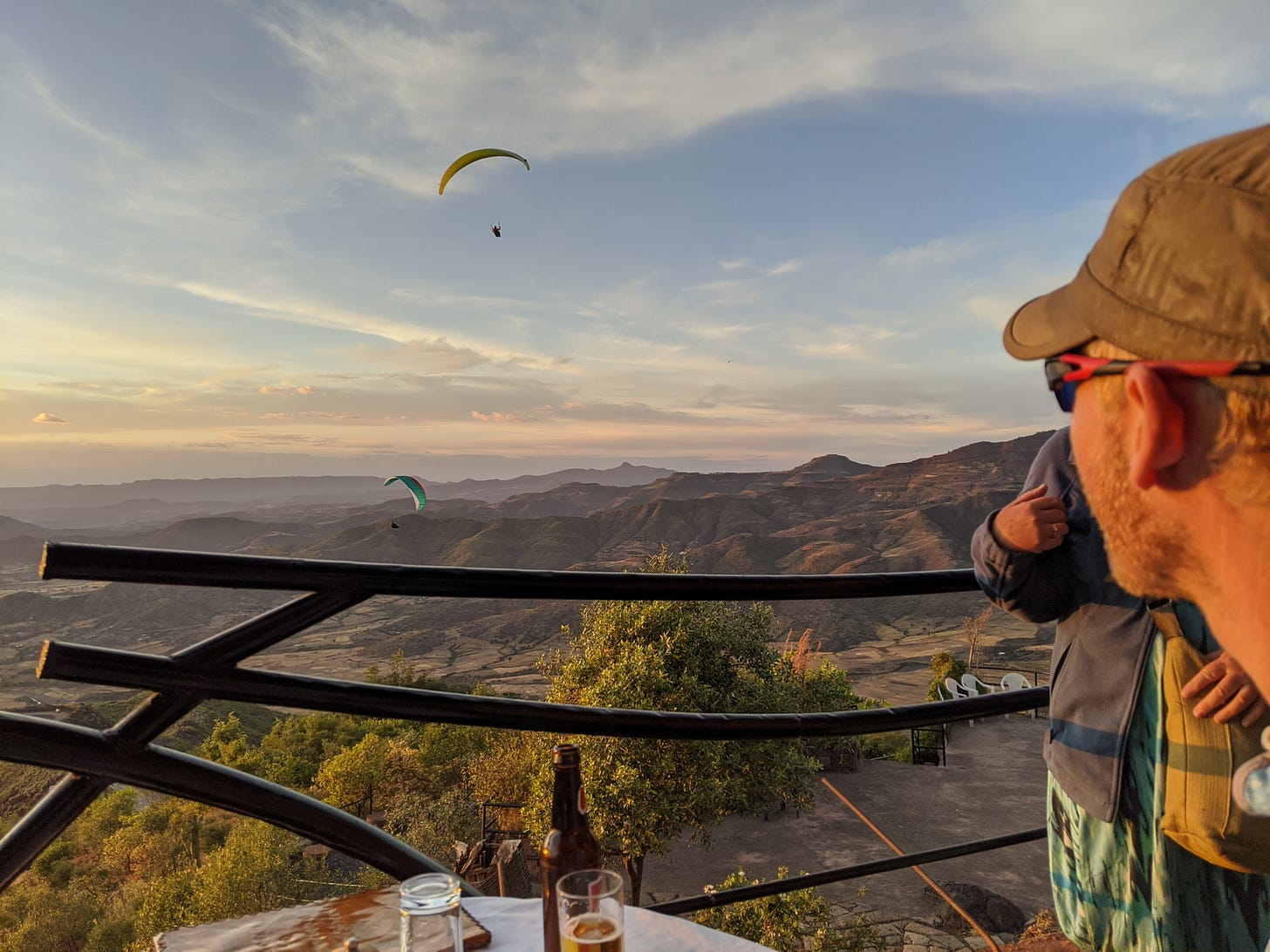
View of paragliders from a one-of-a-kind restaurant, Ben Ababa, in Lalibella. It was built by a Scottish woman and has very unusual architecture, serves decent food, and employs local youth.
After our time in the Middle East, Ryan and I returned to Africa, to a country that blends middle eastern traditions with African traditions, and has an incredibly rich history — Ethiopia. Ethiopia was home to some of the first humans, and was front and center for the birth of Christianity and Islam, AND is the birthplace of coffee and rastafarianism! Remember the fossil, Lucy, the “missing-link” hominin? Lucy was found in Ethiopia and her actual bones rest in an unimpressive glass box in the basement of a simple and unglamorous museum in Addis Ababa, the capital of Ethiopia. Human consumption of coffee is storied to have begun with an Ethiopian goat herder, and evolved into a hot beverage with Ethiopian monks. Ethiopia was one of the first countries to declare itself Christian in the first centuries after Christ’s death. The story goes that a King of Ethiopia in the Axumite era had two servant boys from the Levant who converted him to Christianity. Ethiopia is also woven into the origins of Islam, as the Prophet Mohammed had an Ethiopian nurse. You have probably also heard of Bob Marley’s religion Rastafarianism. Rastafarianism originated with the decadent crowning an Ethiopian prince*.
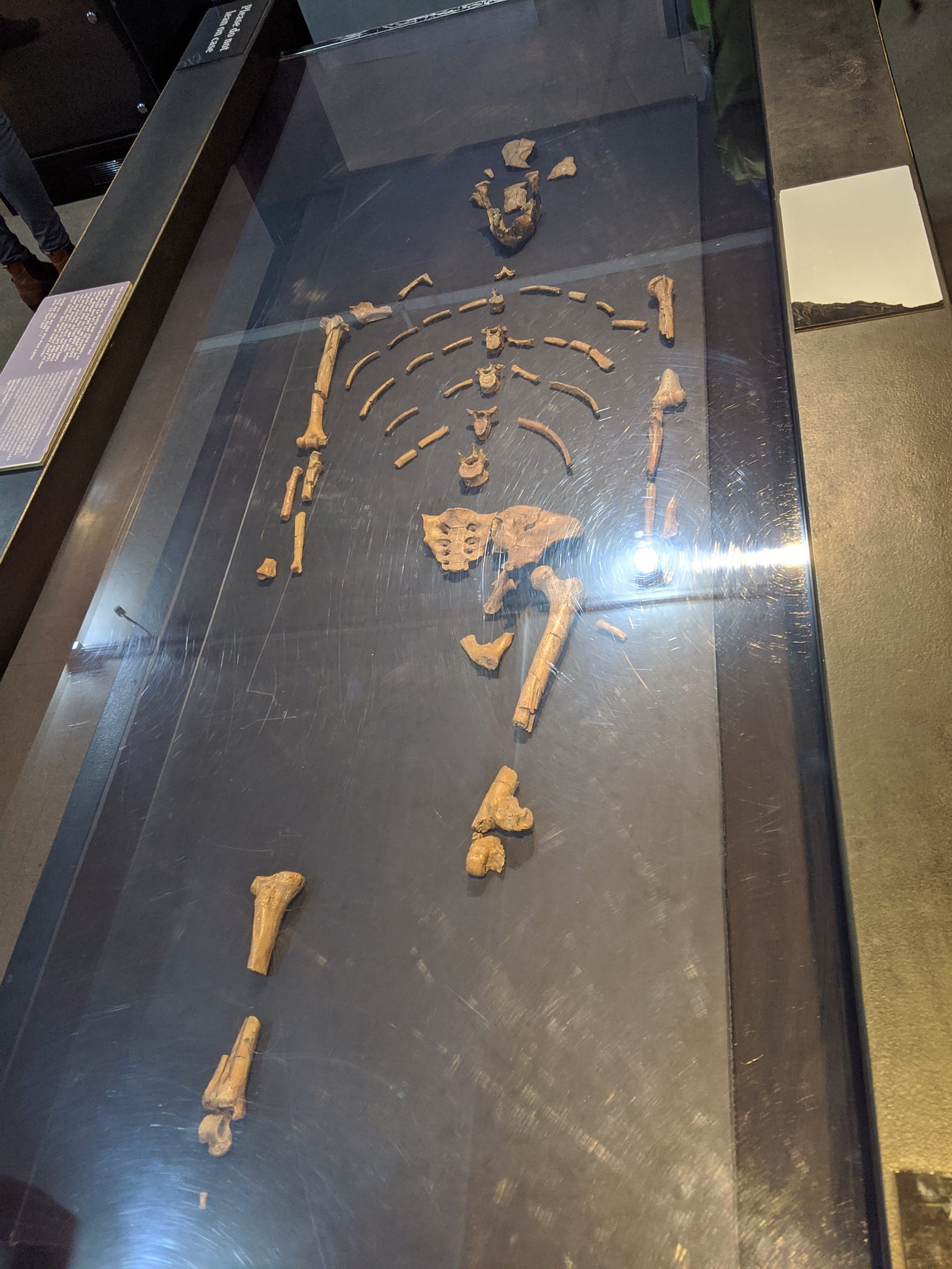
The real bones of the fossil, Lucy housed in the basement of the bare bones National Museum in Ethiopia.
Ethiopia is a strange place; it was never colonized and so many of its traditions are unfamiliar. They speak Amharic, a language that has its own unique script, and blends Bantu languages with Arabic. Ethiopia uses a different calendar derived from the Egyptian calendar. There are thirteen months and a leap day every 4 years. It's seven years behind our Gregorian calendar due to differences in interpretations of the date of Jesus’ birth declaration. The time of day is measured by hours since sunrise or sunset, so 1 o’clock is either one hour after sunrise or sunset.

Ethiopian numerical script, sculpted in the cow dung covering of a building in a new art gallery in Addis Ababa. Nichole took us there not knowing what to expect, and this house covering was the only art in the whole ‘gallery’. All the rooms were empty and the grounds were an edible garden/farm. We asked the people there, ‘where is the art?’, and they said, ‘it’s all art!’ 🤣
For the most part, Ethiopians working with tourists use western time and dates, so it’s not as confusing to get around as it sounds. Traveling in Ethiopia was very do-able, but not comfortable. The food here is often not what you would find in an American Ethiopian restaurant. Rather than a spread of lentils, greens and a variety of meat sauces on injera, you are more likely to find a tomato sauce blended with beans and pasta on injera. If you get tired of this, it’s hard to find western food other than mediocre pizza. We only had good WiFi one night of our whole trip, ATMs run out of money easily and have very low maximums. Both Ryan and I had stomach problems a couple times, hotel standards are not western, and Taxi fares and directions can be challenging.
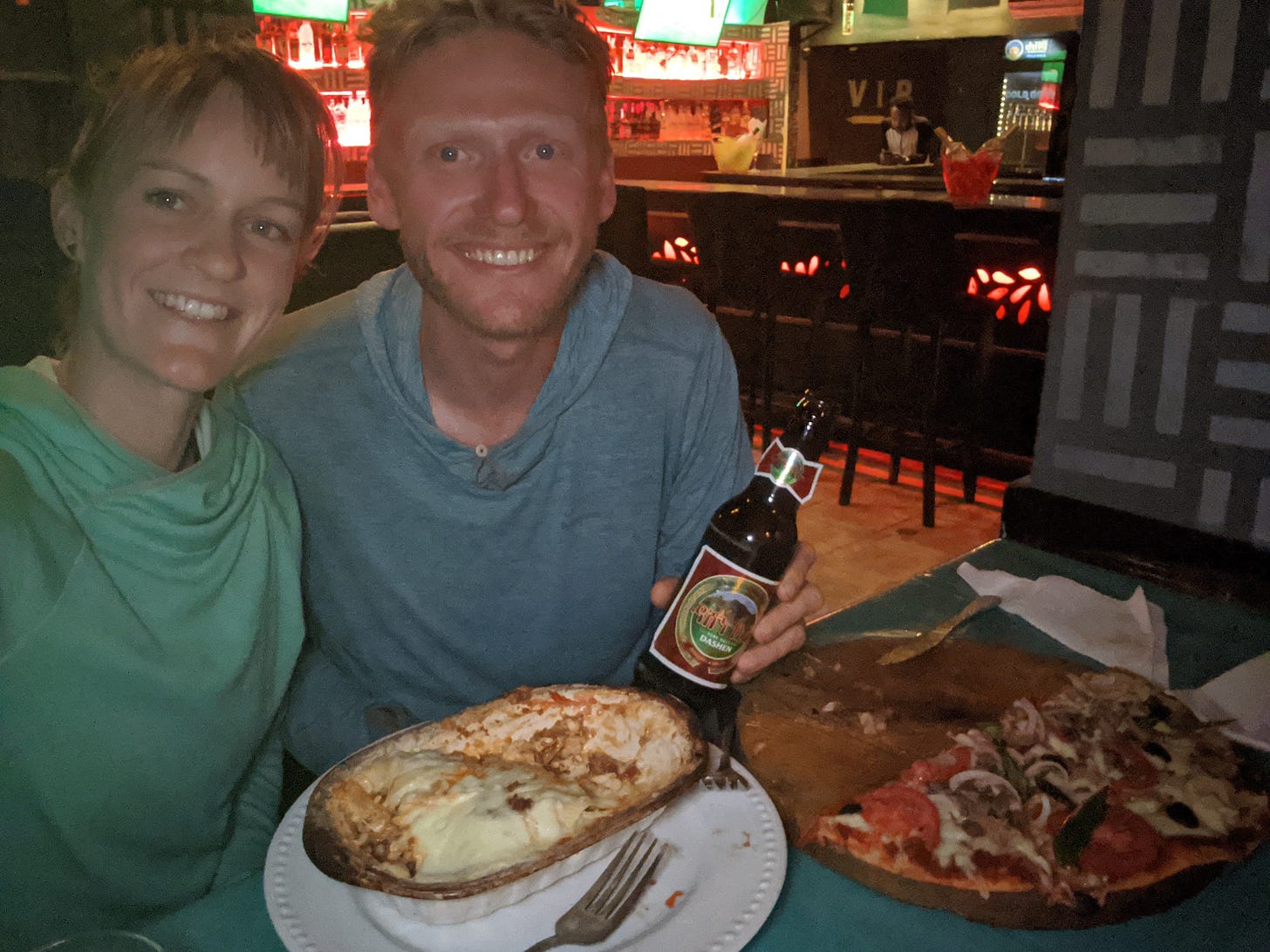
Our Thanksgiving day meal, at a bar in Gonder rumored to have decent lasagna. 😜
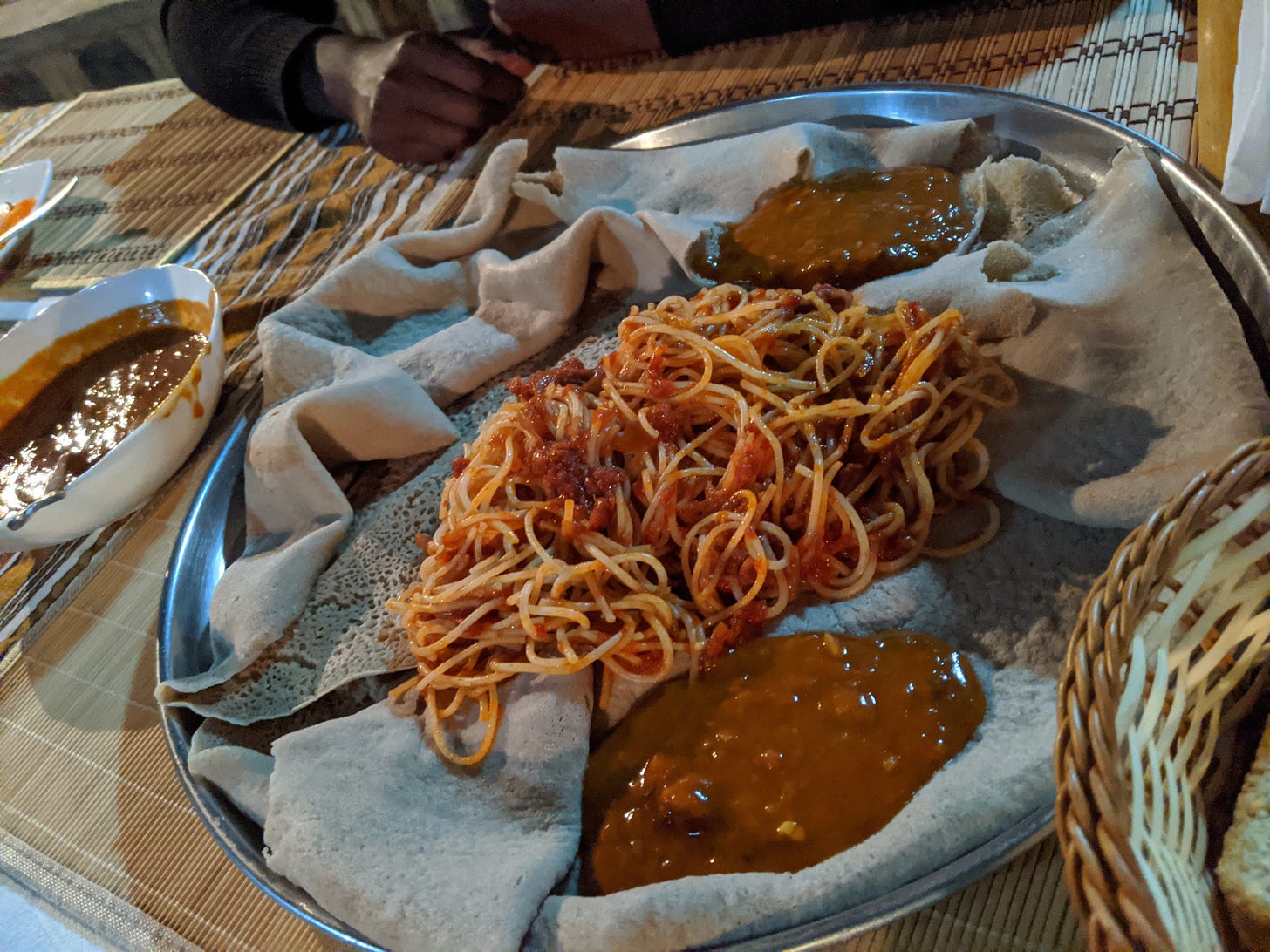
Local budget Ethiopian food. Shira, a blended chickpea/tomato/onion sauce, pasta, and bread on injera.

One of the really great meals we had in Ethiopia.
Our first introduction to Ethiopia was through our friend, Nichole, who is living in Addis Ababa conducting research as part of her surgical residency. Nichole also did the Peace Corps in Ethiopia, and is very integrated into the culture and language of Ethiopia. She hosted us at her apartment and immediately recruited us in the battle for fair taxi fare (😏) in Addis Ababa. She told us the fare to her apartment from the airport should be $8 maximum, and we should not pay more. When we found a taxi, we haggled but could not get him to accept less than $10, and so accepted it. Nichole later told us that some drivers will simply refuse to drive for a normal fare. Getting around in Addis Ababa is not easy. We had to have our taxi call Nichole, and she had explain directions to him in Amharic over the course of three phone calls before the driver made it to a corner one street away from Nichole’s house, where Nichole came out to the street and found us. Many streets do not have names, or if google maps gives the street a name, it doesn’t correspond to a name used by locals. Many locals navigate by landmarks that may or may not be obvious to tourists. Recently, an Uber-like app called GetTaxi came to Addis Ababa. The challenge of directions and taxi driver refusal to drive for low fares, meant that Nichole was spending a lot of time explaining directions and haggling for a fair fare until GetTaxi. This app has been a huge time saver for Nichole. Even though many drivers don’t know how to read the map and you often have to explain directions, she no longer has to haggle and sometimes the drivers know how to read the map!

Nichole introducing us to tej, delicious local honey wine.
Nichole introduced us to the local specialities: raw beef eaten with a horseradish sauce and injera, a local delicious honey wine called tej, a mixture of sprite, sweet white wine and beer called Tekeshino, and a mild drug called chat. Chat is a bush with oval shaped thick leaves, and locals eat it in little bundles that look like bouquets made from a random hedge. There are traditions surrounding its consumption. Typically you wash the leaves and then pick the leaves off one at a time making a fist of leaves to eat at once, then you chew the leaves in the side of your mouth and then swallow or spit the leftover masticated fibrous ball. It’s a sign of affection to gift a fistful of leaves to a fellow chat chewer. The taste is quite bitter with sweet overtones, and people typically eat peanuts and soda while chewing it to wash away the bitter, dry taste that overtakes your mouth. After an hour of chewing this large bundle of leaves, you eventually feel a bit energetic and euphoric. The first time we tried chat we barely noticed its effects, but the second time we tried it, I noticed being quite hot and significantly more energetic; I was eager to listen to conversation and appreciate scenery. This effect was still mellow, but definitely noticeable and lasted for a few hours.
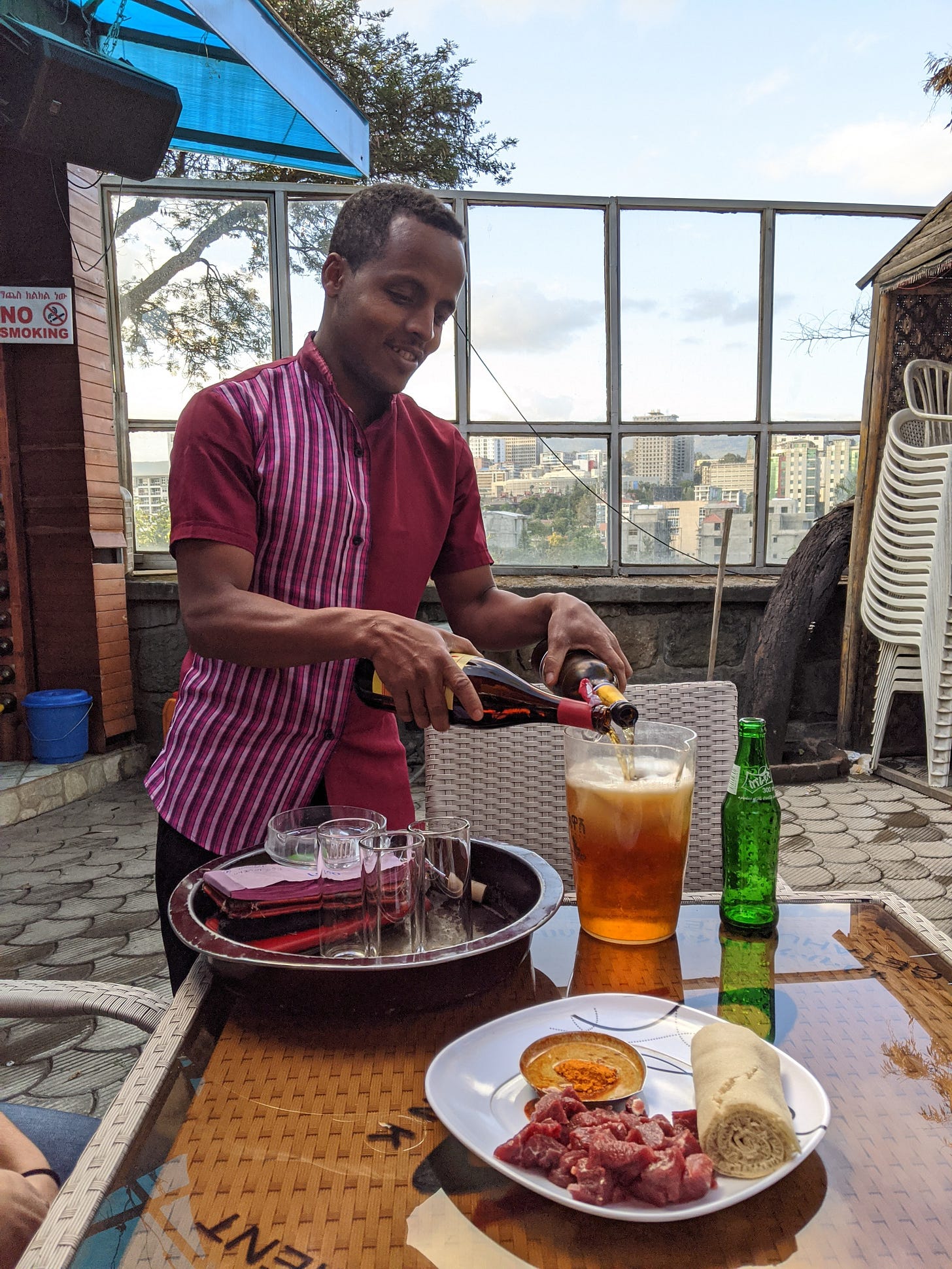
A waiter making us the preferred local cocktail, tekeshino (sprite, wine and beer) in front of the local delicacy, raw beef eaten with a horseradish sauce and injera bread. The raw meat with horseradish was a lot like sushi with wasabi. Delicious!
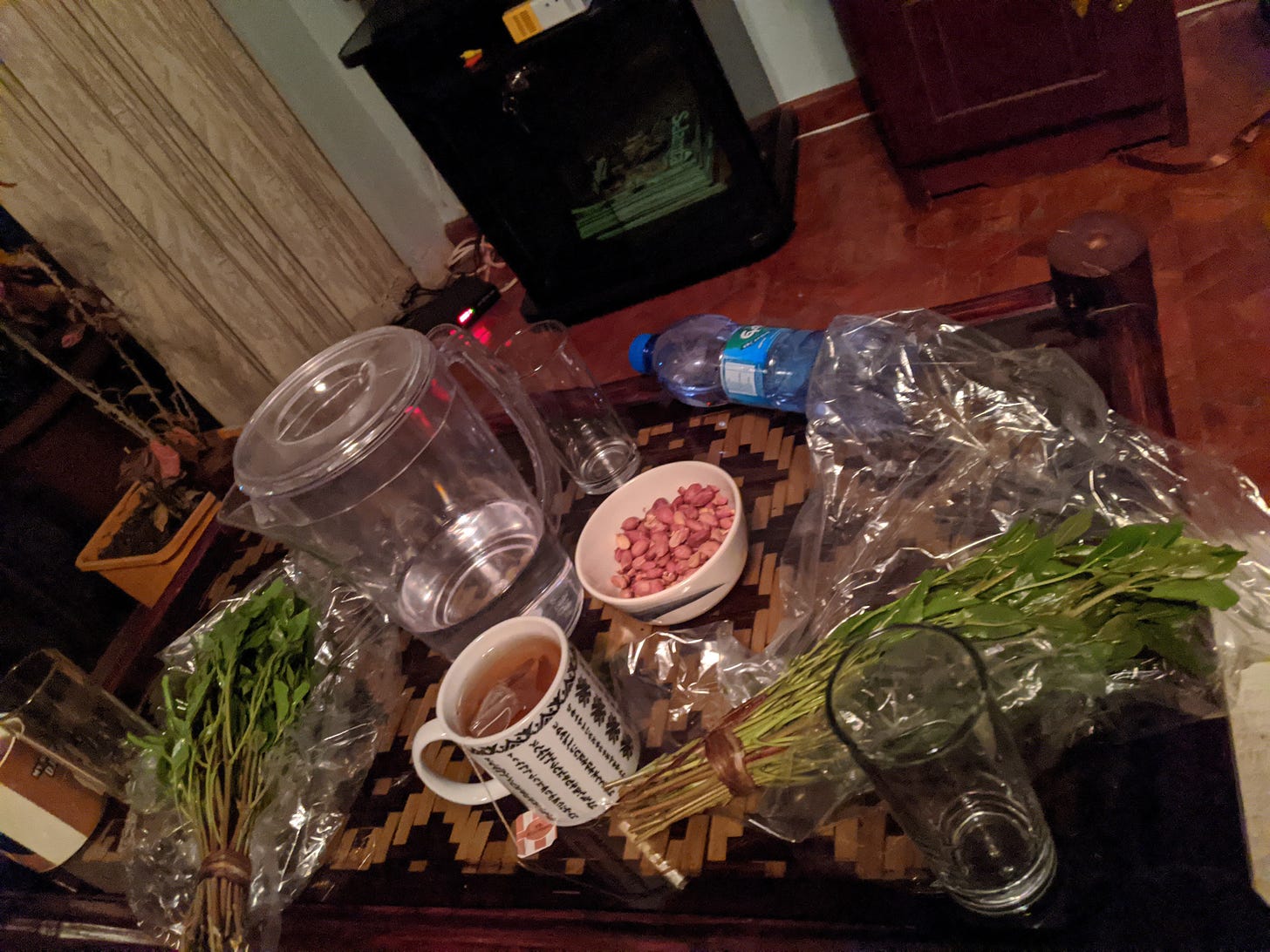
The chat ceremony. Bundles of chat leaves with peanuts and drinks to wash away the bitter flavor.
Nichole also took us to Addis Ababa’s first Italian coffee shop. Coffee was first cultivated and drank in Ethiopia, and it is still a large part of the culture. The story goes that an Ethiopian shepherd was herding his goats and noticed that they were energetic after eating a red berry. The shepherd tried chewing the red berry and brought it to monks, who developed the modern style of roasting and drinking it. Coffee plants and excellent espresso is ubiquitous throughout the country, made by women roasting green beans in a frying pan, hand grinding them with a mortar and pestle and boiling them in a pot of water, and drinking it black. Our best cup of coffee in the country was at a restaurant where a woman running the coffee ceremony fried some green beans on the spot and made us fresh coffee.
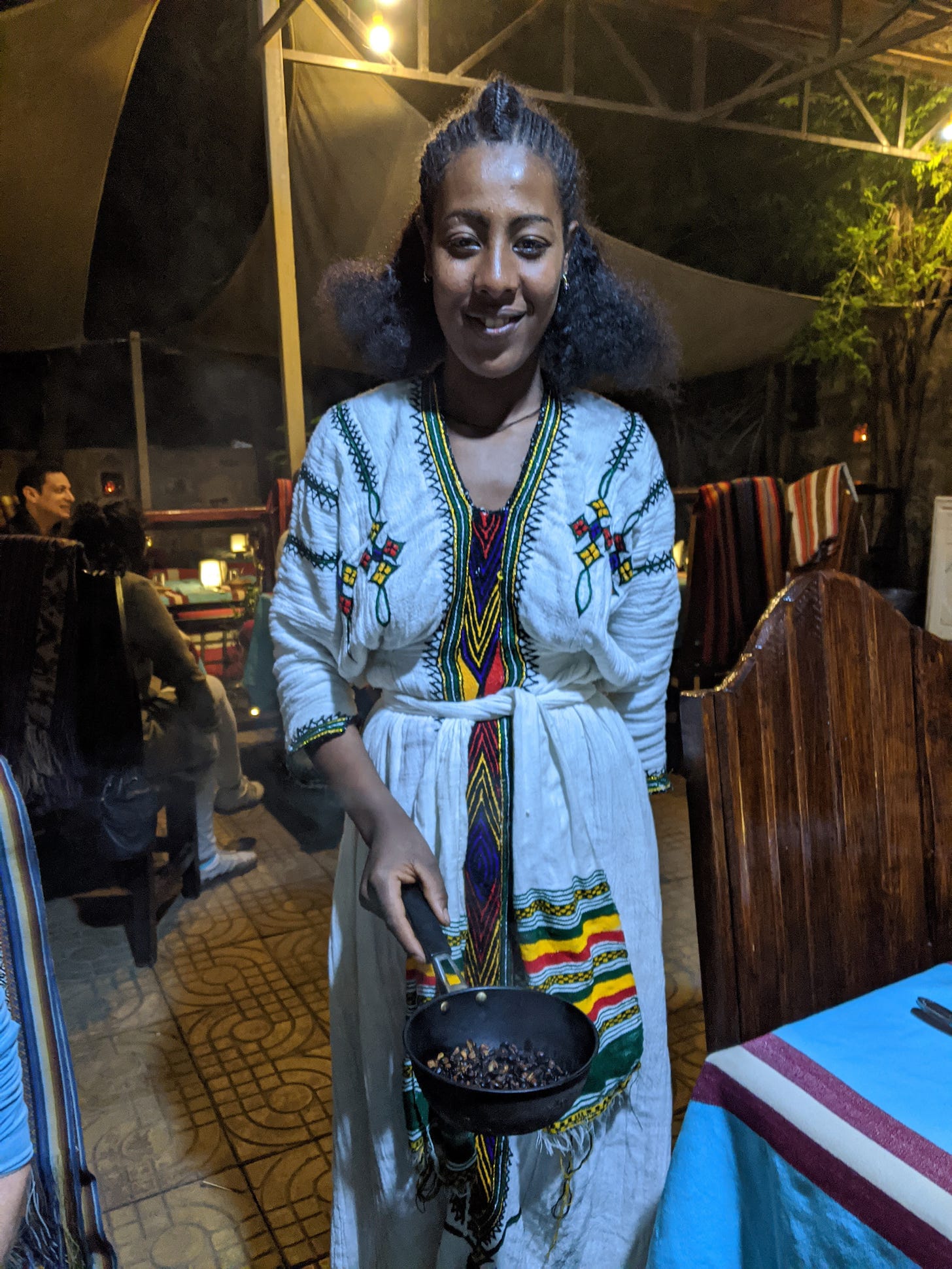
A waitress allowing us to smell the smoke from the freshly roasted coffee beans of the coffee ceremony. Her hairstyle is one of many funky, fresh hairstyles that I saw Ethiopian ladies rocking.
Ethiopia means “land of the burnt skin” in Greek, because the people there are a beautiful blend of light skinned Arabs and dark skinned Africans. In their tradition they are ruled by Kings and Queens descending from a fateful union of the mythical Queen of Sheba and the Israelite King Solomon in the 10th century BC. The rich history of Ethiopia spans three eras, each with their own capital cities in Northern Ethiopia— Axum, Lalibela, and Gonder. Although we later learned that northern Ethiopia is not difficult to tour without a tour company, we were tired of planning things for ourselves at this point in the trip and we decided to book a two week tour with a company based in Addis Ababa. This company toured us to these three ancient capitals, via a series of short, cheap domestic flights.
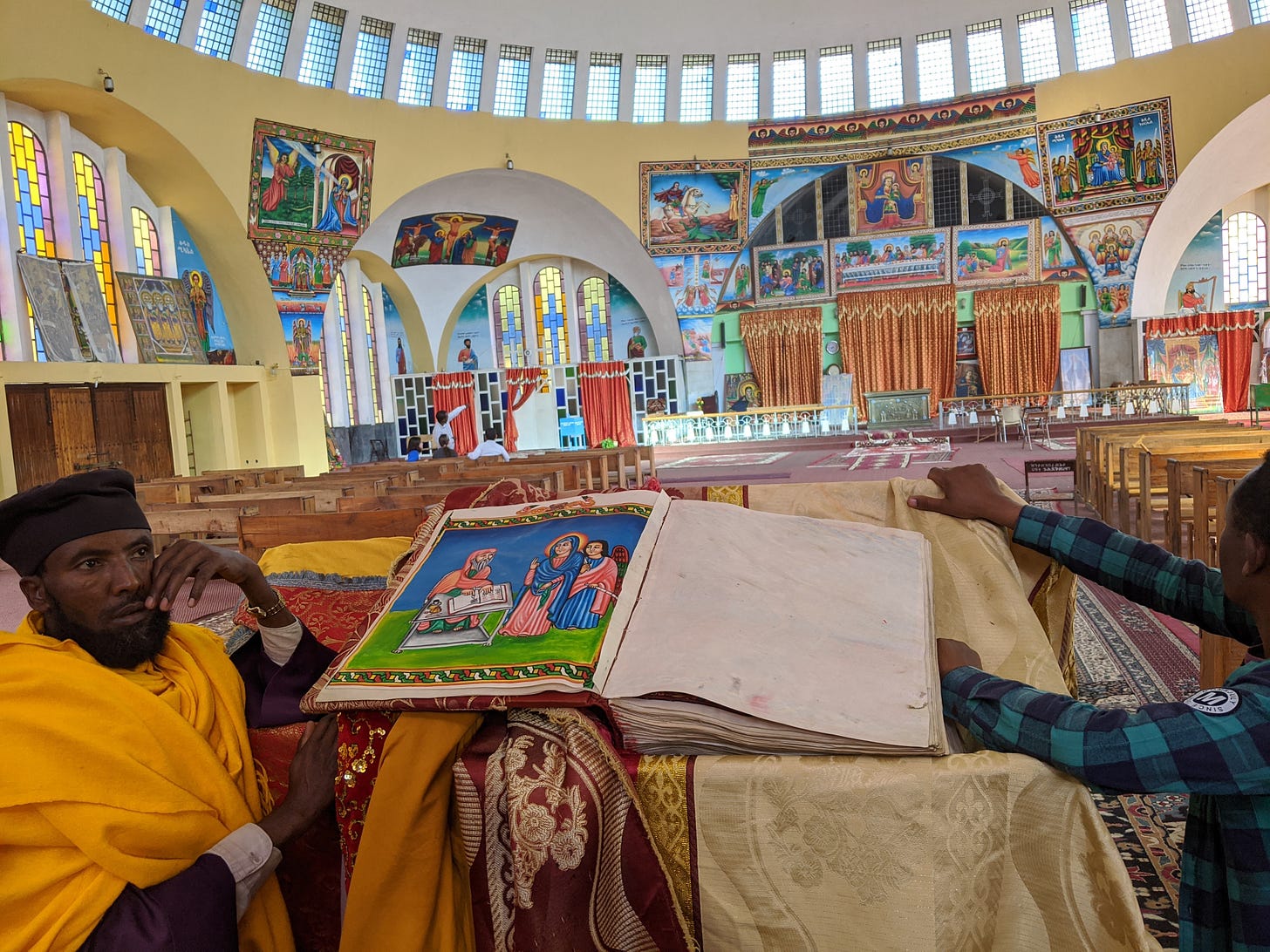
St Mary of Zion church, where the Ark of the Covenant is rumored to be kept in a nearby guarded house.
We started in Axum, capital of the great Axumite kingdom, the city from which Queen of Sheba is rumored to have ruled one of the great kingdoms of the ancient world. Although the Queen of Sheba is suspected to be a mythical historical figure, many Ethiopians consider her a central part of Ethiopian history. We toured the ruins of an ancient castle and drainage in Axum, that is described to be her castle and ancient baths. In the Bible, the Queen of Sheba visited King Solomon with a unprecedentedly voluminous caravan of fine incense and gold, to show her respects to the Israelite kingdom and test the new king. The Ethiopians expand on the story, saying that King Solomon had never seen a beauty like hers before and so he tricked her into sleeping with him. Queen of Sheba then returned to Axum and gave birth to a son, named Menelik. Menelik eventually wanted to travel to Jerusalem to meet his father, King Solomon, and his mother eventually allowed him to go. It was on returning from this trip to Jerusalem, in the first century BC, that the Ark of the Covenant was brought to it’s supposed resting place in a guarded church in Axum, Ethiopia. This son then became King, starting a long line of succession that ties its roots to King Solomon. Although we were allowed to visit the church, St Mary of Zion, visitors are not even allowed near the building that houses the Ark, and the Ark itself is closely guarded and only visited by the priest. No one, not even the priest is allowed to open the Ark to see the 10 commandment tablets rumored to be inside.
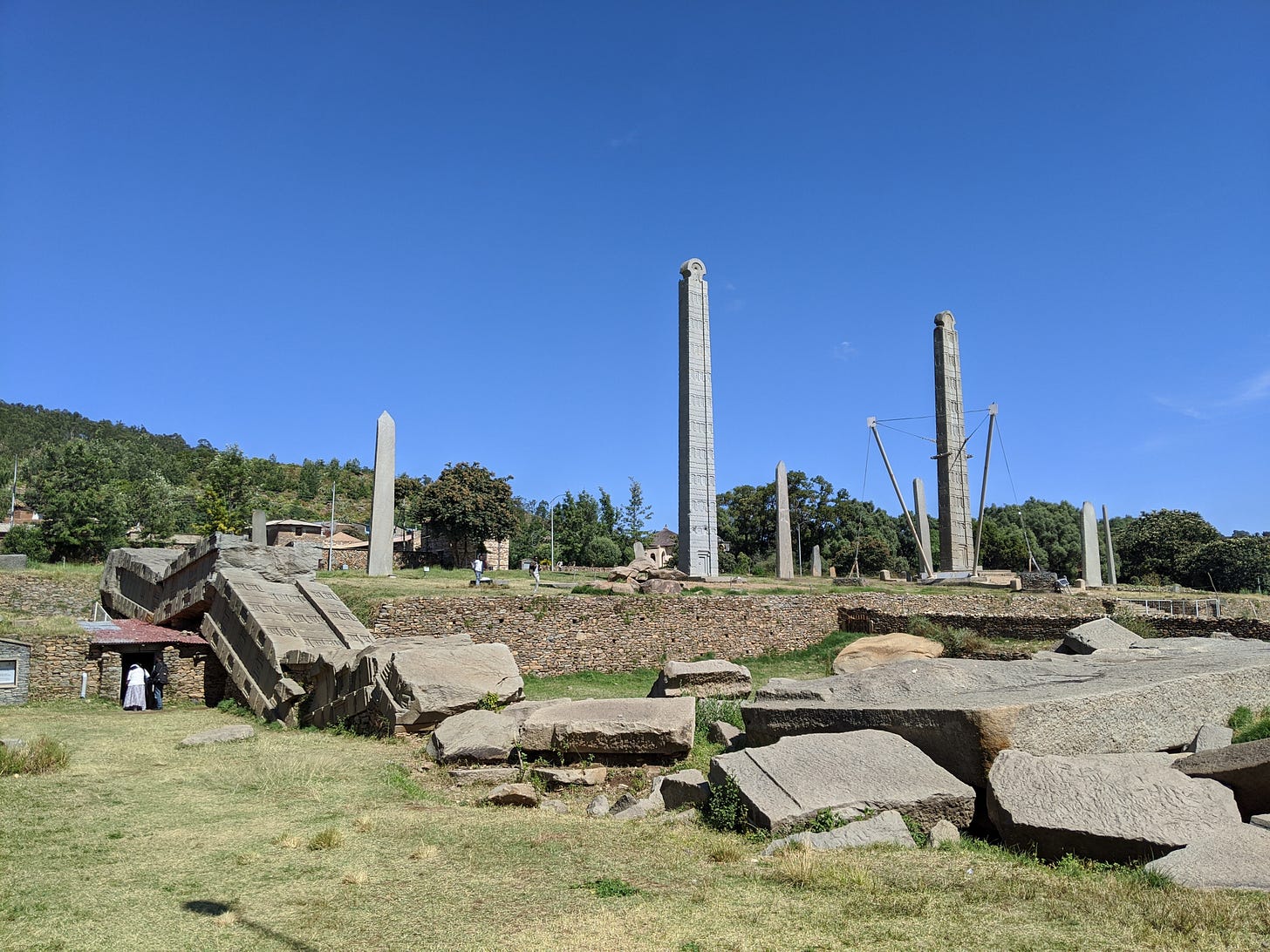
The obelisks marking tombs of important people from the great ancient Axumite kingdom. A 33m fallen obelisk is seen in the foreground; this is thought to be the biggest stone monolith that man ever attempted to erect.
The Axumite kingdom was very rich and highly organized. Like the ancient Egyptians, they were excellent stone masons. They carved and erected many impossibly large granite monolith obelisks that still stand today. These obelisks acted as tomb stones over the graves of important people, in an ancient pagan religion. Some are roughly hewn, standing only 3 feet (1 m) tall. The most impressive stones rise 20-30m into the air, much larger than the Egyptian obelisks and painstakingly carved. The largest obelisk is believed to have been the largest stone monolith ever attempted to be raised by humans at 33m tall and over 520 tonnes, but it lies fallen and broken on the ground probably due to a fall during the erection process. This fallen obelisk was the last built, and coincides with Ethiopia’s official conversion to Christianity around the year 300 AD.
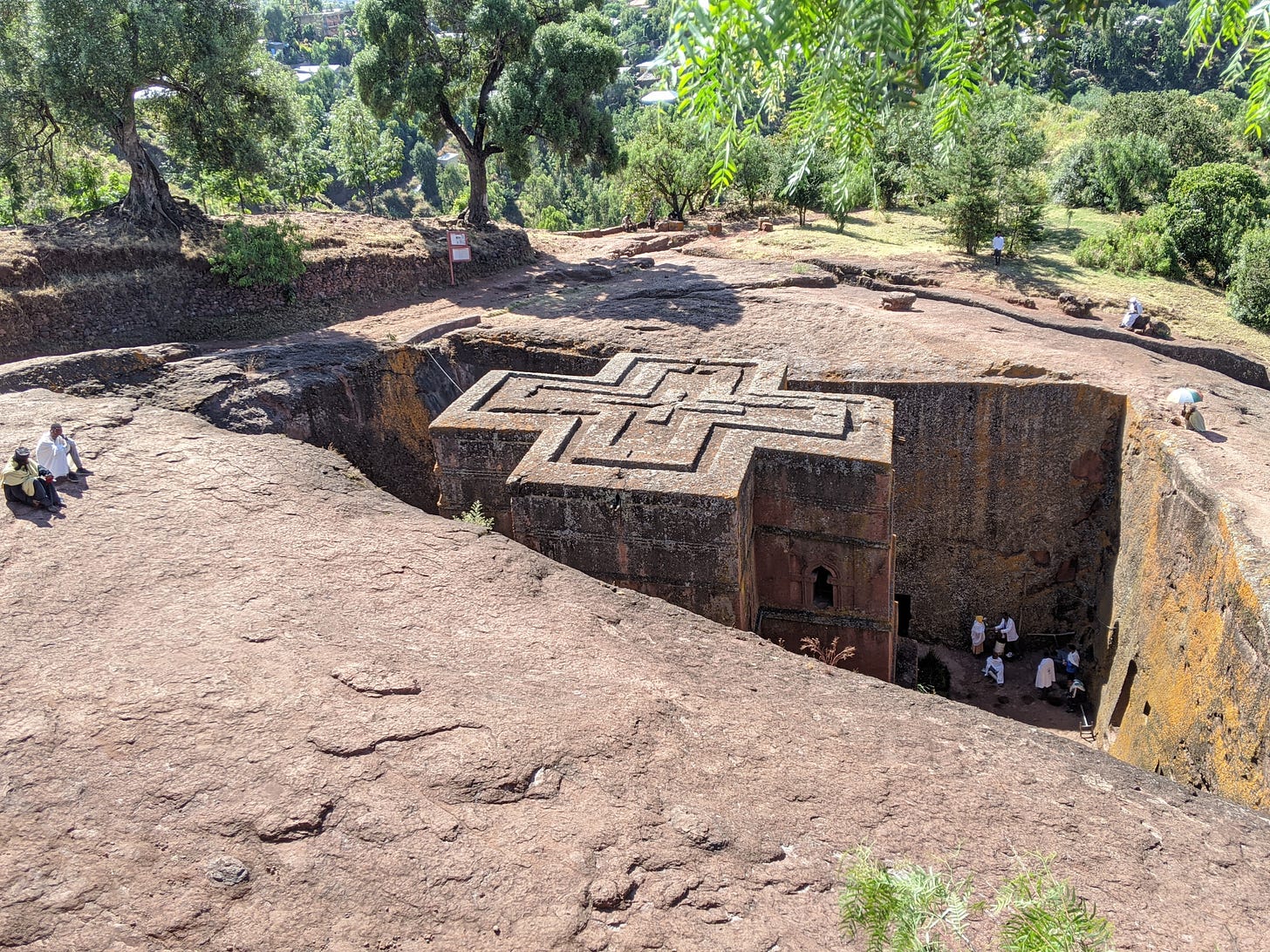
St George’s church, the last and most famous church in Lalibela.
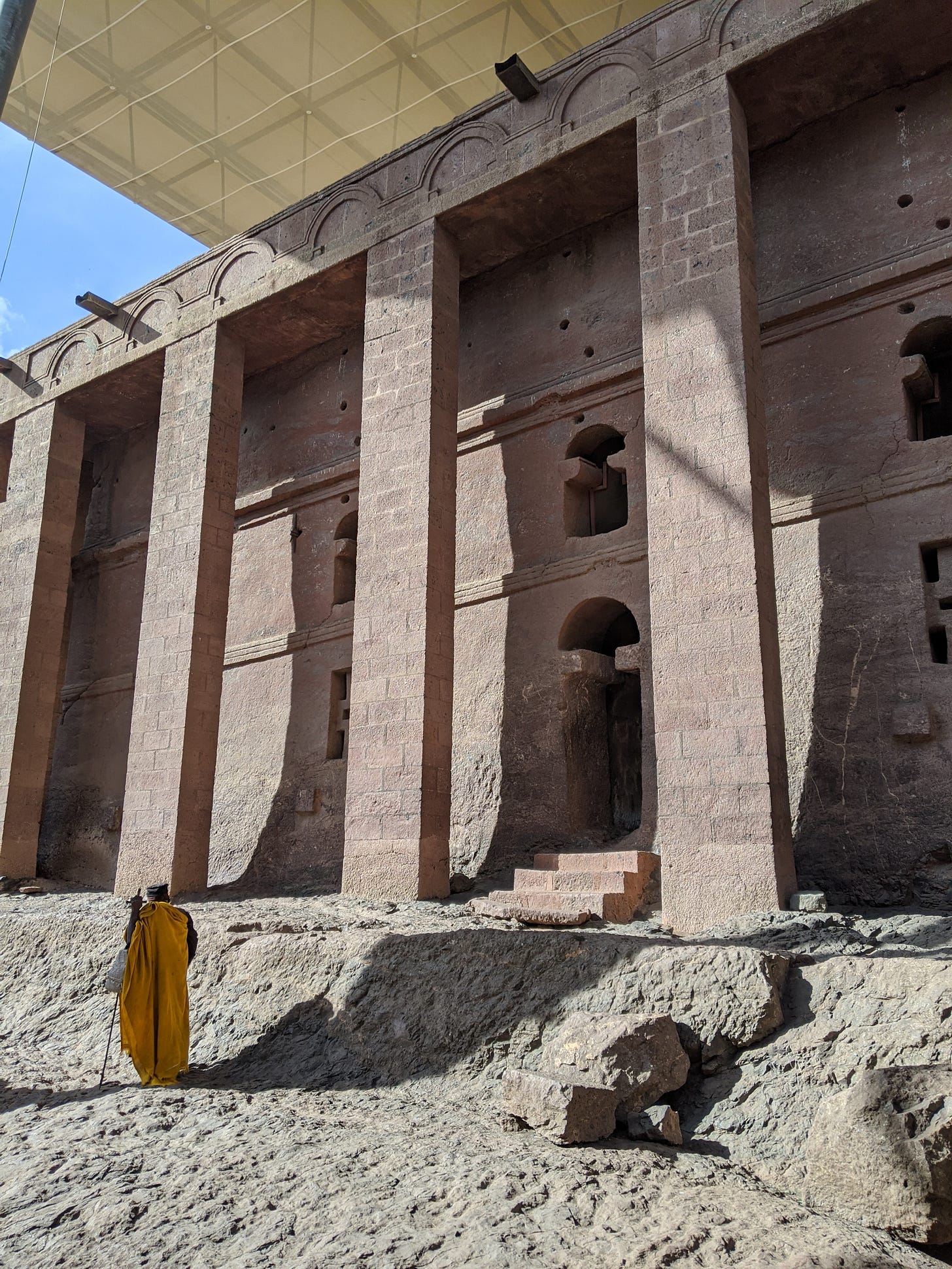
An Ethiopian priest stands looking up at one of the monolithic churches from the subterranean trench surrounding it. Some columns have been restored, and UNESCO has installed a covering over the church to protect the roof from rain erosion.
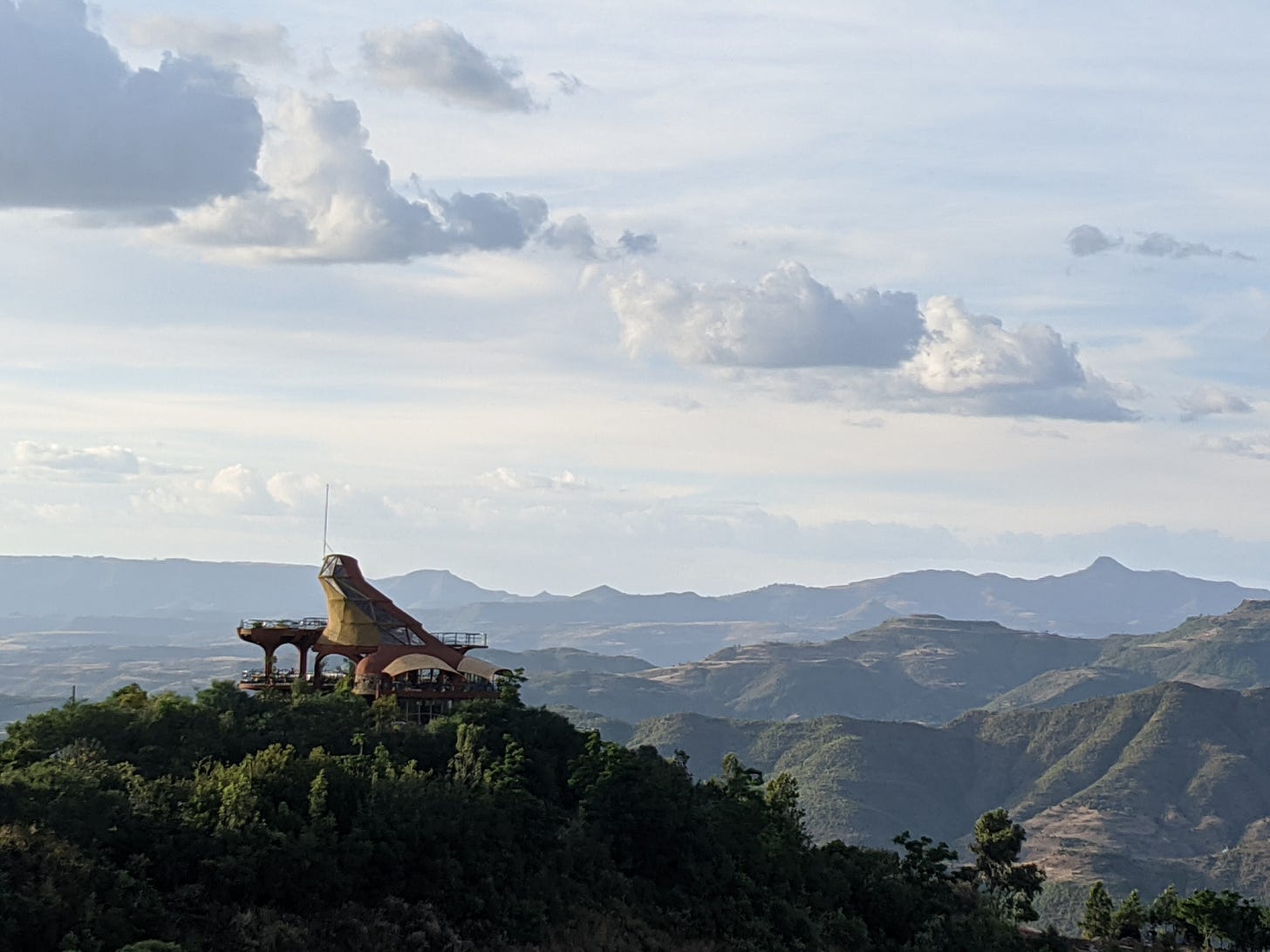
Ben Ababa, a restaurant in Lalibella with incredible architecture and views.
In the 12th century, the Zagwe dynasty began a new capital near a modern day city called Lalibela, and carved 12 churches out of rock there. Supposedly, King Lalibela wanted to save Ethiopians from the arduous pilgrimage to Jerusalem by making a New Jerusalem at Lalibela. The churches are carved in relief from the ground, the rock inside them painstakingly removed, and large courtyard space is dug out surrounding the churches. Their inside and edifices are elaborately carved. The locals will tell you that the churches were all carved out of the ground by King Lalibela himself in 23 years with the help of angels in the night time. They are supposedly built underground to keep them from the sight of invading armies trying to ransack the churches. Seeing the churches was truly spectacular, it is impossible to imagine the effort and skill that was required to bring these monolithic stone churches to life.

Inside a church on a remote peninsula near Gonder.
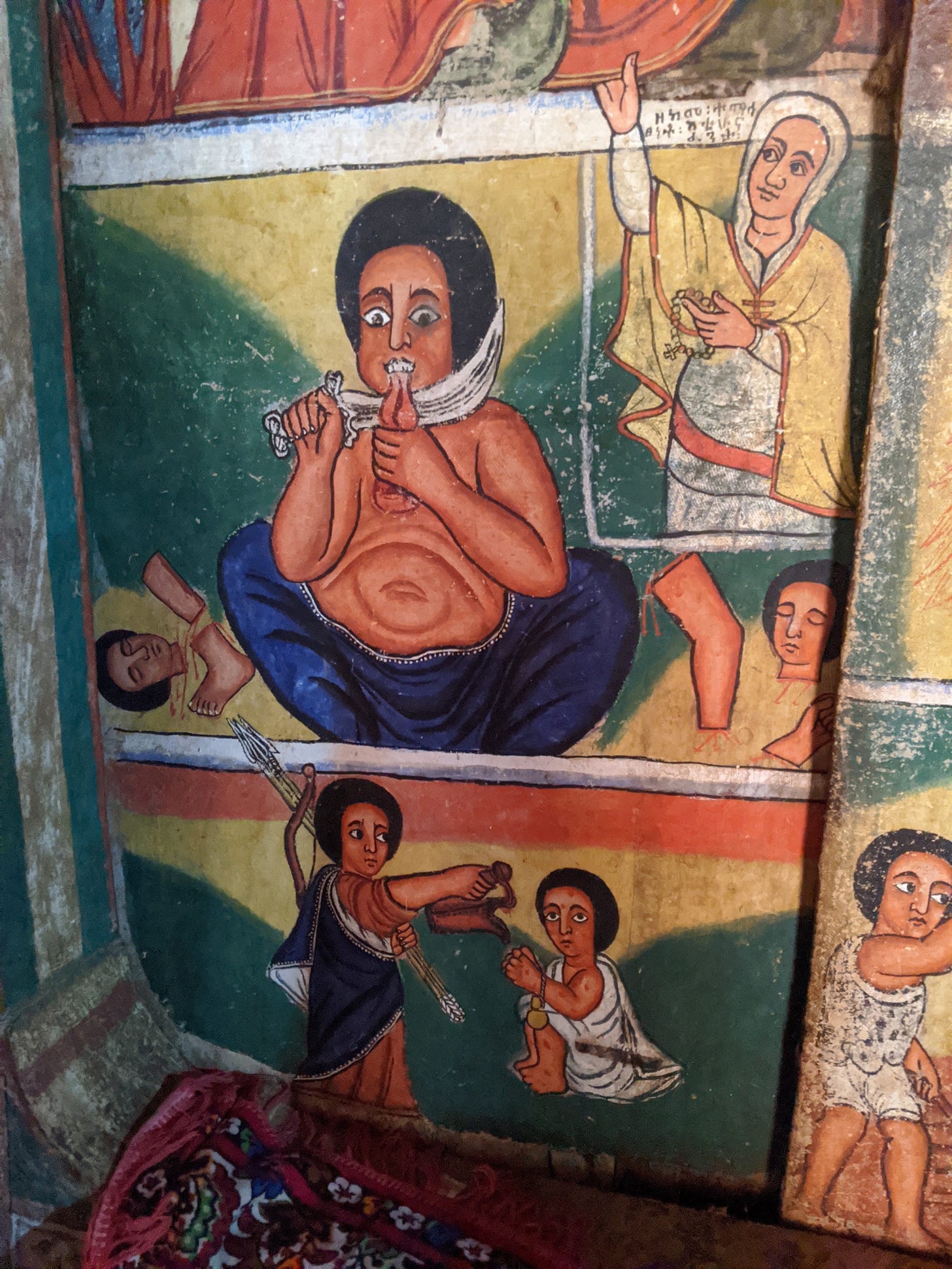
The Cannibal of Qamar eating a leper.
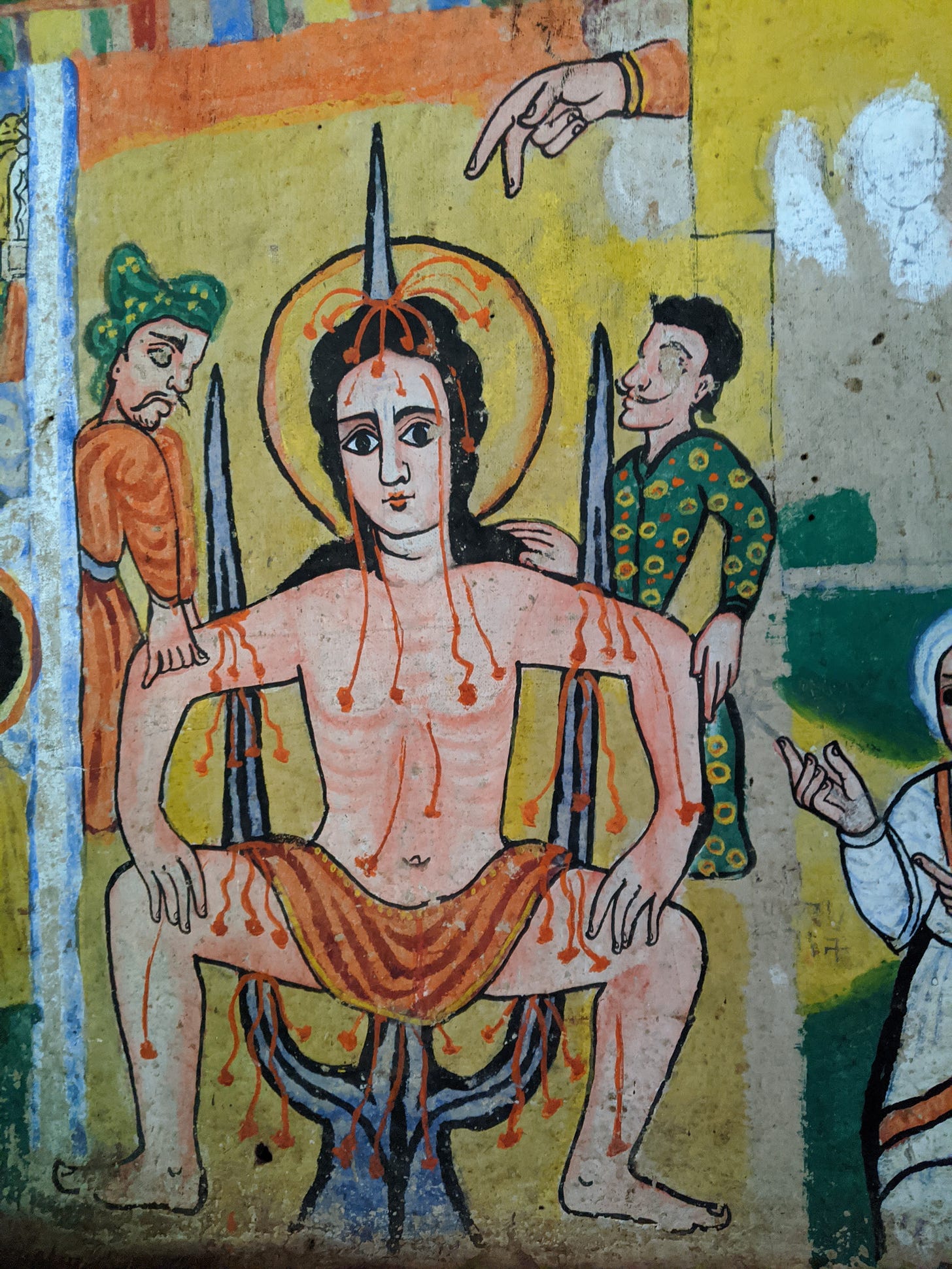
One way that St George, Ethiopia’s patron saint, was killed.
All the churches we saw across Ethiopia impressed us with their colorful paintings and interior decoration. The painted images were also surprising because of their casual violent depictions. As Ethiopia converted from pagan animism to Christianity very early without European missionaries, many Ethiopia legends wove themselves into Ethiopian Christianity. An example of this is the story of The Cannibal of Qamar, the story of a man who ate dozens of people, but had his soul saved by Mary on Judgement day. The story of Ethiopian’s patron saint, St George, is also told in its most gruesome form. St George is a Christian martyr celebrated in many places are the world, but Ethiopia particularly focuses on a dozen ways he was tortured and murdered for his beliefs. St George’s violent deaths, and other tales like the Cannibal of Qamar make for some gory church murals.
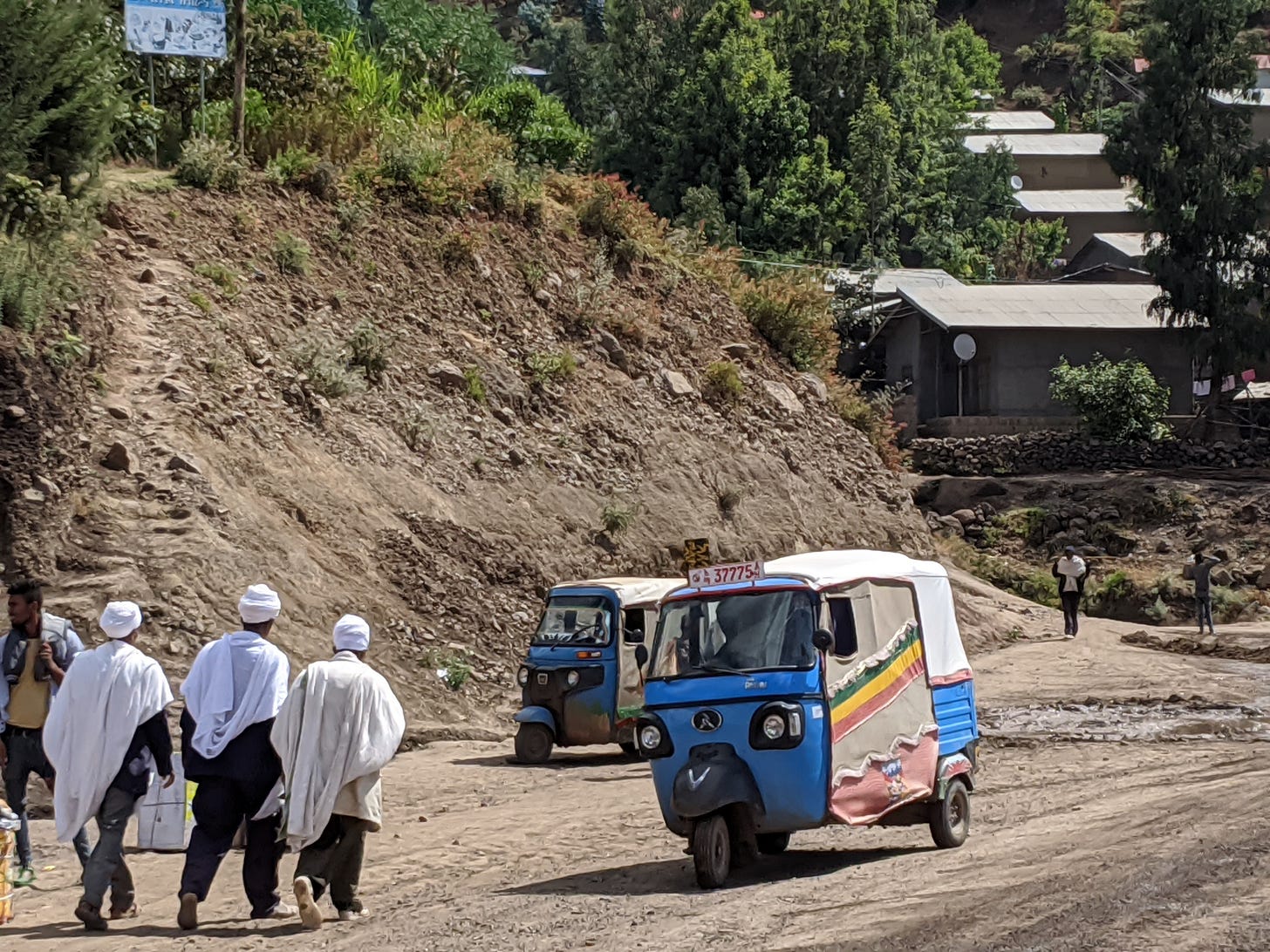
The North of Ethiopia is full of these blue, elaborately decorated tuktuks that the locals jokingly refer to as blue mosquitos. The traditional dress for men and women in Ethiopia is to wear a white cloth wrap around their heads and bodies.
The North of Ethiopia, including Axum and Lalilbella, has a unique style of dancing that focuses on quick, repetitive shoulder motions. Both men and women are amazing shoulder dancers! Sometimes they also bob their head forward and back or left and right with the shoulder motions in mesmerizing bird-like movements. At the show that we went to in Axum, the performers came down from the stage and danced with audience members. The girl that I was dancing with brought me up on stage and made me dance with her in front of everyone for a solid 10 minutes. She dressed me in a religious shawl and gave me a large hat, and then tried to get me to follow along with her coordinated head bobs and shoulder moves while moving around the stage.
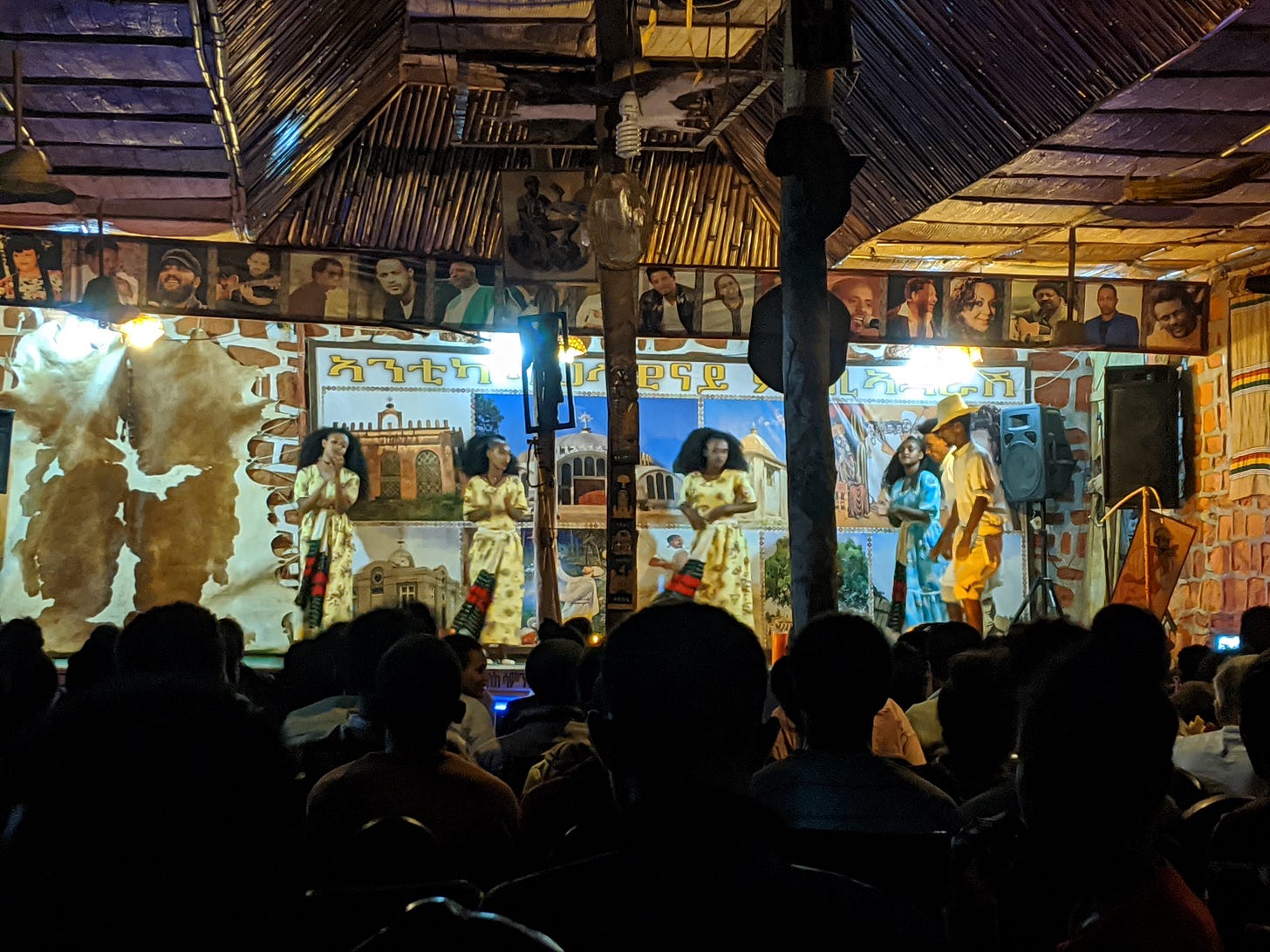
Drinking tej and watching northern Ethiopian shoulder dancing at a bar called Antica in Axum.
The final capital city before Addis Ababa, was Gonder. Gonder became a capital in the 17th century probably due to its position in the highlands at 2133 m (6998 ft), out of the heat and the reach of malaria and the tsetse fly, and its critical position at the intersection of three caravan routes. The ruins of a castle compound remembers the days when the city was a wealthy hub ruling over 65,000 people.
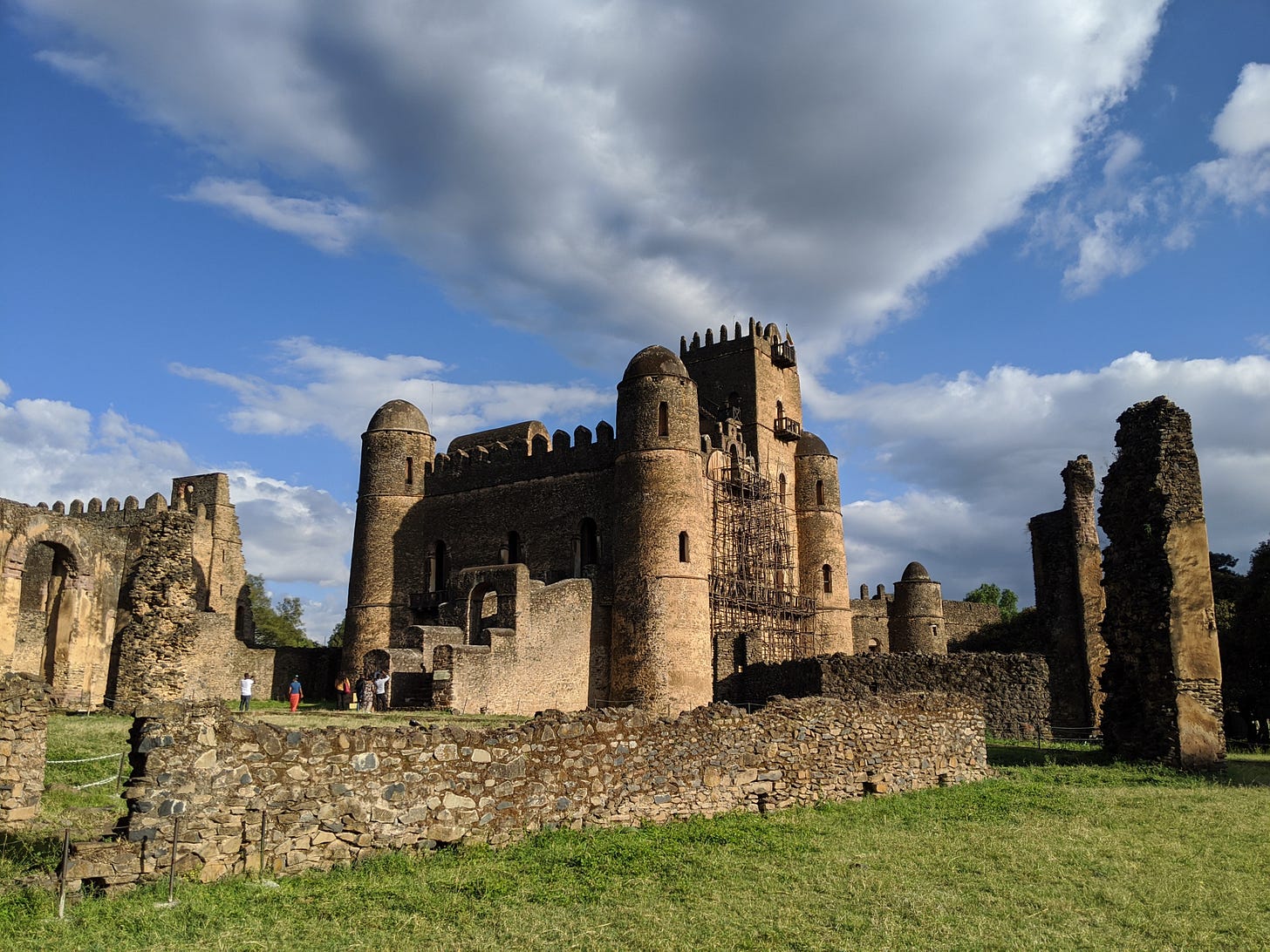
Castle in Gonder.
Gonder is also the gate to the Gonder mountains, a stunning plateau above dramatic green escarpments home to a unique species of monkey called Geladas. We only did a day trek in Gonder, but many people were doing multi-day treks. It is one of the most spectacular landscapes I’ve ever seen, so I would highly recommend a multi-day trip.
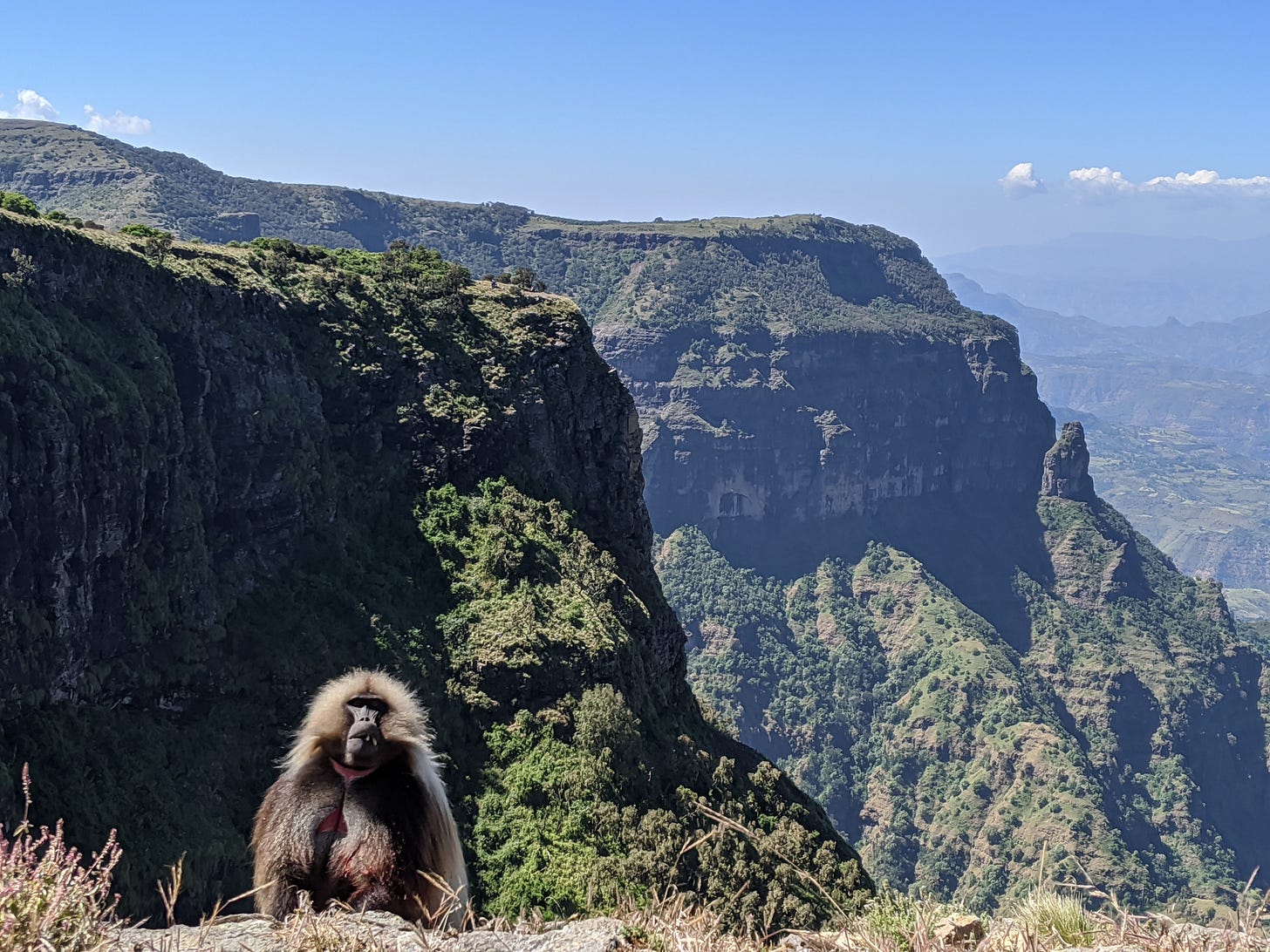
The Gelada monkeys in the Gonder mountains.
After exploring the empires of Northern Ethiopia, we started traveling south to visit the remote tribes of the Omo Valley. At the start of this journey, our local guide took us to his hometown, a Rastafarian community. We got a coffee at his favorite local coffee shop, where women were roasting beans and making fresh cups of steaming coffee. It was very good, although I was scared I was going to get sick from drinking whatever water they were using to make the coffee.
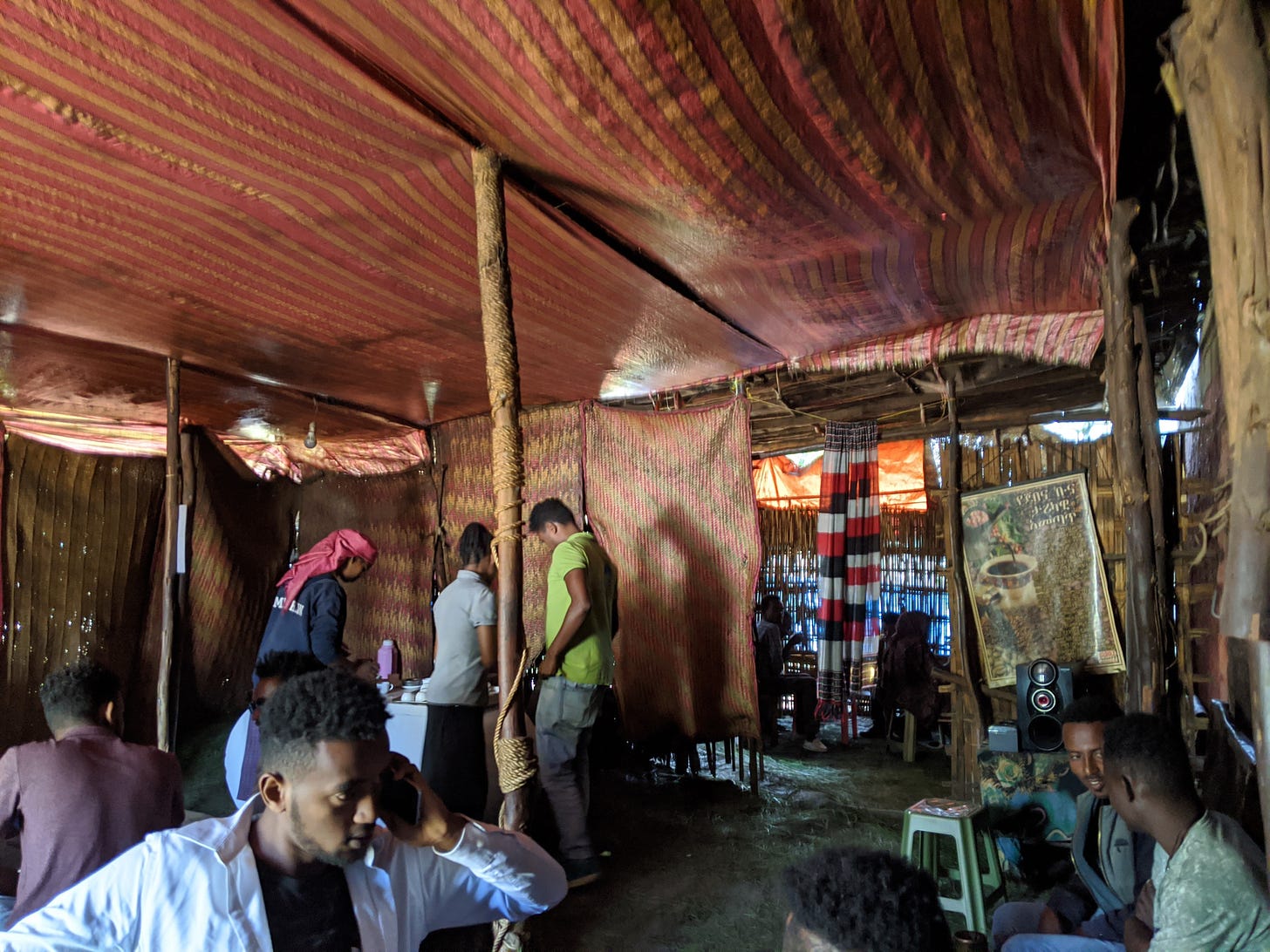
Coffee at a shop in a Rastafarian community with our local guide, who is from this community. The women running the shop were pan roasting the beans and making extremely fresh, tasty coffee. In Ethiopia, restaurants commonly cover the ground in fresh cut grass to add a sense of freshness.
* Ethiopian prince Ras Tafari was crowned to become King Haile Selassie in 1930. This decadent event sparked excitement about great African Kings, and turned Haile Selassie into a symbol of African power, especially for African diaspora in Jamaica. Rastafarianism regards Haile Selassie as an incarnation of god or an important Rasta prophet. Although the religion is most prevalent in Jaimaica, there is also a large community of Rastas in Ethiopia.
